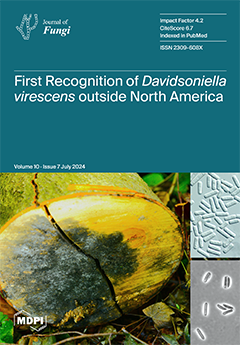Medicinal mushrooms, especially
Ganoderma species, hold immense promise for the production of a wide range of bioactive compounds with various effects. The biochemical potential of indigenous fungal strains, specific to a region, could play a critical role in the continuous search for novel strains with superior activities on a global scale. This research focused on the ethanolic (EtOH) and hot-water (H
2O) extracts of fruiting bodies of two wild-growing
Ganoderma species:
G. pfeifferi and
G. resinaceum, with the aim of assessing their nutritional (total carbohydrate content-TCC) and mineral composition in relation to bioactive properties: antioxidant, antiproliferative and lipid-lowering. Atomic absorption spectrophotometry (AAS) revealed that
G. pfeifferi is a promising source of minerals that are essential for numerous physiological functions in the human body like bone health and muscle and nerve function, with Ca (4.55 ± 0.41 mg/g d.w.) and Mg (1.33 ± 0.09 mg/g d.w.) being the most abundant macroelement present. Zn, Mn, and Cr were particularly notable, with concentrations ranging from 21.49 to 41.70 mg/kg d.w. The EtOH extract of
G. pfeifferi demonstrated significantly elevated levels of TCC, essential macromolecules for energy and structural functions in the body, with higher quantities of all three standard carbohydrates detected in this type of extract. Similar to the revealed composition, the same species,
G. pfeifferi, stood out as the most prominent antioxidant agent, with the H
2O extract being stronger than EtOH in the ABTS assay (86.85 ± 0.67 mg TE/g d.w.), while the EtOH extract displayed the highest anti-OH
• scavenging ability (IC
50 = 0.18 ± 0.05 μg/mL) as well as the most notable reducing potential among all. The highest antiproliferative effect against the breast cancer cell line (MCF-7), were demonstrated by the H
2O extracts from
G. resinaceum with the most pronounced activity after 24 h (IC
50 = 4.88 ± 0.50 μg/mL), which surpasses that of the standard compound, ellagic acid (IC
50 = 33.94 ± 3.69 μg/mL). Administration of both
Ganoderma extracts mitigated diabetic lipid disturbances and exhibited potential renal and hepatic protection in vivo on white Wistar rats by the preservation of kidney function parameters in
G. resinaceum H
2O pre-treatment (urea: 6.27 ± 0.64 mmol/L, creatinine: 50.00 ± 6.45 mmol/L) and the reduction in ALT levels (17.83 ± 3.25 U/L) compared to diabetic control groups treated with saline (urea: 46.98 ± 6.01 mmol/L, creatinine: 289.25 ± 73.87 mmol/L, and ALT: 60.17 ± 9.64 U/L). These results suggest that pre-treatment with
G. resinaceum H
2O extracts may have potential antidiabetic properties. In summary, detected microelements are vital for maintaining overall health, supporting metabolic processes, and protecting against various chronic diseases. Further research and dietary assessments could help determine the full potential and applications of the two underexplored
Ganoderma species native to Serbia in nutrition and health supplements.
Full article






